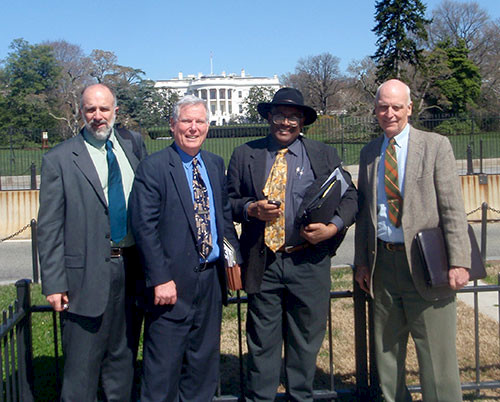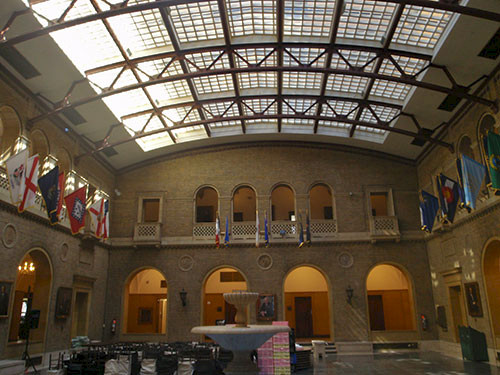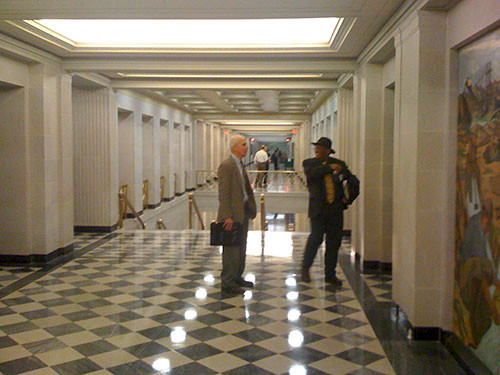Friends of the Bay go to Washington, D.C.
Bill Dennison ·A group of concerned former politicians, scientists and riverkeepers converged on federal agencies in Washington, D.C. to discuss Chesapeake Bay restoration. This loosely associated group has been convened by Gerald Winegrad, a former Maryland state senator from Annapolis, and currently totals 38 people. The group includes two former Maryland governors, a former U.S. senator, former U.S. congressman. The purpose of the meetings with senior federal officials is to advocate on behalf of Chesapeake Bay. At a meeting in November 2009, the "Friends of the Bay" drafted 24 bold recommendations to enhance Chesapeake Bay restoration. These recommendations were publically released at a press conference in the Maryland State House in late December, resulting in print and electronic media coverage. The central theme in the recommendations is that the 25 years of largely voluntary efforts to restore Chesapeake Bay have been inadequate. The concerned politicians, scientists and riverkeepers are calling for regulatory actions and enforcement to complement the voluntary efforts (e.g., carrot AND stick measures).

As a follow up to the press event, a series of briefings between a subset of the overall "Friends of the Bay" group and various federal agencies were initiated in January. The first event was held at a Management Board meeting of the Chesapeake Bay Program, which included the representatives from the state partners, federal agencies and the Chesapeake Bay Program. Later in January, delegates from the group made a visit to Washington, D.C. to the Environmental Protection Agency (EPA) and Department of Interior headquarters. At the EPA, we met with the Deputy Administrator, Bob Perciasepe, Assistant Administrator for Water Peter Silva and the new EPA Regional Administrator for Region III Shawn Garvin. Jeff Lape, Chesapeake Bay Program Director also attended. Bob Perciasepe was a former Maryland Secretary of Environment and was well informed about Chesapeake Bay issues. Bob Perciasepe told us that our group had the "gravitas" to make people pay attention and listen. He encouraged us to press our cause in other meetings with federal officials and Bay state officials.
Following the EPA visit, a short introductory meeting was held with Will Shafroth, Deputy Assistant Secretary of Interior for Fish and Wildlife and Parks. Will had to cut our meeting short to meet with his boss, Secretary of Interior Ken Salazar but invited us to schedule a follow up meeting where we could specify recommendations relevant to the Department of Interior, particularly the National Park Service, U.S. Geological Survey and the U.S. Fish & Wildlife Service.
We attempted to meet with the Department of Interior in February but were thwarted by a succession of snowstorms. The rescheduled March meeting included, in addition to Will Shafroth, Deanna Archuleta, Deputy Assistant Secretary of Interior for Water and Science and Mike Gauthier, National Park Service Liaison to the Assistant Secretary. In addition, Will had a half of dozen agency folks associated with the Chesapeake Bay Program join via conference phone. We had a stimulating discussion about the capabilities and deployment of federal agency staff on behalf of Chesapeake Bay. The most encouraging aspect of their response to our recommendations was their interest in following up with specific actions. Will encouraged us to continue to "hold our feet to fire", indicating a desire to be held accountable regarding the Chesapeake Bay Executive Order, signed by President Obama.

Following our Department of Interior visit, we grabbed some lunch at an outdoor café and headed over to the Department of Agriculture. We walked in front of the White House, by the Washington Monument and across the Mall. It was a gorgeous spring day and the Department of Agriculture building is directly on the Mall across from the Smithsonian Natural History Museum.

The Department of Agriculture lobby had a large skylight, and there was an impressive waiting room for the conference room where the meeting was held. It turned out to be National Agriculture Day, and they were setting up for a reception and dinner. We met with Robert Bonnie, the Special Advisor to the Secretary for Environment and Climate, Dave White to the Secretary of Agriculture, Robert Bonnie, Dave White, Chief of the Natural Resources Conservation Service (originally the Soil Conservation Service) and his Deputy Undersecretary, Ann Mills. The NRCS is charged to work on conservation with private landowners and the context that we engaged with them was the agricultural sector, which contributes the majority of nutrients and sediment inputs into Chesapeake Bay. As we had done with the Department of Interior, we tailored our recommendations for relevance to the Department of Agriculture. The overall theme established was that the soil, fertilizer and manure needed to remain on the farms to grow crops more efficiently and out of the Bay where they cause water quality degradation. The importance of better targeting the agricultural best management practices and providing feedback on effectiveness of conservation efforts was emphasized. In addition, the issue of stimulating innovation for dealing with chicken manure in the Chesapeake watershed was discussed. The need for follow up meetings to establish specific recommendations was established.

These visits to federal agency officials have been encouraging. The federal officials come to the meetings well briefed and pose excellent questions. There is some deflection, however, where they quickly establish the limits of their impact and say that we really should go talk with someone in another department. We were quick to point that out to them when it occurred, and they generally did not repeat this tactic. Rather, we did focus in on what their agency could realistically achieve to support Chesapeake Bay restoration. One of the interesting aspects of visiting the headquarters of various agencies was the 1930s vintage architecture, wall murals and furnishings. It is hard to say what the net result of these meetings will be, but we are encouraged enough to continue to advocate for Chesapeake Bay restoration.


About the author
Bill Dennison

Dr. Bill Dennison is a Professor of Marine Science and Vice President for Science Application at the University of Maryland Center for Environmental Science.

